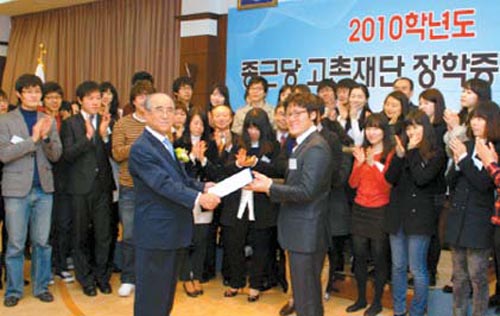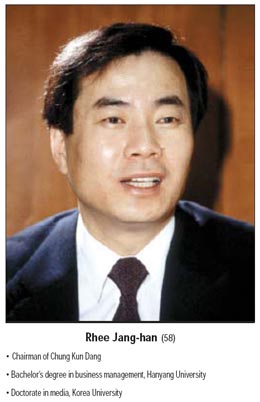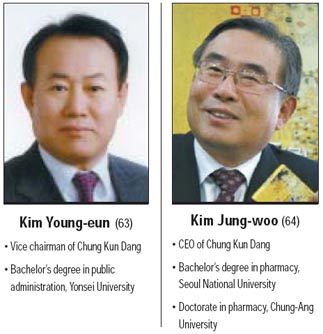A long history of treating disease

The company’s Kochon Foundation provides scholarships to students around the country as seen in a ceremony earlier this year. Provided by the company
The pharmaceutical company hasn’t let its status as one of the oldest conglomerates in the country stop it from pursuing new innovations through strategic cooperation with global companies.

The bell that can also be seen in the company’s logo symbolizes morning prayers. It is rumored that the founder’s mother sold bean sprouts at Yeongcheon market in Seodaemun. Being a devoted Christian, she would always visit the church on her way to the market, while holding a huge bucket of bean sprouts on her head.

But Lee was ambitious, setting up the company’s first research lab in 1949. It developed Korea’s first tube-type thiadiazole ointment.
In 1951 Chong Kun Dang became more of a wholesaler than a simple pharmacy, as Lee created separate production and sales units and started to make ephedrine hydrochloride pills and serotonin tablets. By 1956 the company was already manufacturing 30 different drugs, and it registered as a corporation that year.
It survived the Korean War, and went on to set up a strategic alliance with a Danish company that produced antibiotics and blood pressure medication in 1957. In 1965 it set up Asia’s largest plant manufacturing raw materials for antibiotics, and just three years later it became the first Korean firm to receive U.S. Food and Drug Administration (FDA) approval for a drug.
After becoming the first pharmaceutical company in the country to export antibiotics, it signed strategic alliances with U.S. and British pharmaceutical companies in 1971 and 1972.
In 1980, Chong Kun Dang established Korea Rhone-Poulenc Rorer, a joint venture, to enhance its share of the local market. In 1983 the company jointly set up Roche Korea with the Swiss company. The group posted $20 million in exports in 1989 and started producing the company’s first liquefied digestive medicine, Sokcheon, that same year.
The company later succeeded in developing the nation’s first next-generation peptic ulcer treatment pill, omeprazol.
By the end of 1991 it had six affiliates, plus the Kochon Foundation, founded in 1973 as a training institute for Chong Kun Dang employees.
Today Chong Kun Dang not only manufactures pharmaceuticals but also makes glass and handles real state and construction. The founder passed away in 1994, but his eldest son Rhee Jang-han continues his father’s legacy.
Rhee, who majored in business management in college, built up experience working at Roche Korea and Rhone-Poulenc Rorer Korea as a top executive between 1990 and 1993. He is known as an aggressive manager, especially when it comes to research and development.
Right after he moved to Chong Kun Dang, Rhee reformed and expanded the central research center and personally led the development of the nation’s first anticancer drug made of camptothecin. In 1999, the company became the first in the local industry with exports of over $70 million.
Earlier this year the company began selling antibiotics in Brazil. In the first half of this year, Chong Kun Dang was the fifth-largest local pharma firm by revenue, trailing behind Green Cross, Daewoong Pharmaceutical, Dong-A Pharm and Yuhan Corp.
In recent years Rhee has been in a legal dispute with his siblings over inheritance of their father’s shares, but he still has a solid foothold, owning more than 50 percent of the company.
He is also active in the overall business community, with significant positions at several of the top five major business lobby groups in the country including the Korea Employers Federation and the Korea International Trade Association (KITA).
He is also on the Korea Chamber of Commerce and Industry’s ethical management committee and a committee member for Korea-Italy economic cooperation at the Federation of Korean Industries.
Kim Young-eun, vice chairman of Chong Kun Dang, didn’t start his career in the pharmaceutical industry. Kim majored in public administration and worked for Hyundai Motor and the builder Samwhan Corp. before he moved to the human resources department at Chong Kun Dang in 1986. He was later posted in India to help expand the company’s production in one of the largest markets in the world. Since 2002 and 2003, he has been CEO of Chong Kun Dang Health Care and Chong Kun Dang Bio. Until last year, Kim was Chong Kun Dang’s CEO specializing in business management.
Kim Jung-woo, CEO of Chong Kun Dang, is an expert in pharmaceutical products with a doctorate from Chung-Ang University. Kim has worked not only in the manufacturing department but also headed the company’s research center and coordinated its overseas business.
Meanwhile, Kim Young-eun has been overseeing the company’s overall management.
“Despite stronger government regulations on the pharmaceutical industry, Chong Kun Dang has done well through competitiveness and more aggressive expansion of sales resources, helping the company’s revenue in the second quarter to increase by 21.1 percent on-year to 206.4 billion won ($172.3 million) and sending its operating profit up 49.1 percent on-year to 27.9 billion won,” said Choi Jong-kyung, an analyst at HMC Investment and Securities.
“The company will perform well with many of its products, including the high blood pressure treatment dilatrend, losartan potassium as well as hyperlipidemia treatment drugs doing well, and this year’s new products have successfully entered the market in the first half,” said Choi, who believes the company outlook is postive.
By Lee Ho-jeong [ojlee82@joongang.co.kr]










with the Korea JoongAng Daily
To write comments, please log in to one of the accounts.
Standards Board Policy (0/250자)